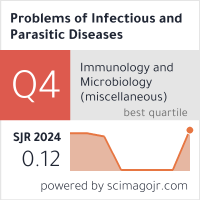IN SILICO DEVELOPMENT OF HIGH-RESOLUTION MLVA TYPING SCHEME FOR ENTEROCOCCUS FAECIUM
DOI:
https://doi.org/10.58395/pipd.v48i1.27Keywords:
Enterococcus faecium, MLVA, MLST, VNTRAbstract
Emergence of enterococci as nosocomial pathogens is frequently associated with hospital outbreaks. Vancomycin resistance is especially perturbing as it limits the possible therapeutic options. Based on vast in silico analysis, we introduce a new multiple-locus variable-number tandem repeat analysis (MLVA) scheme for genotyping of Enterococcus faecium isolates, parameters of which are comparable to these of pulsed-field gel electrophoresis (PFGE) and multilocus sequence typing (MLST). The scheme was tested in silico on all available at this time E. faecium genomes in NCBI Genbank. Searching for suitable variable number of tandem repeats (VNTR) loci was conducted with a set of free access applications. Ten VNTR loci were selected according to their polymorphic structure and stability using the Primer-BLAST utility of NCBI. Primers were designed to be compatible in a multiplex reaction and the method was adapted for high resolution separation techniques. As a result, a total of 60 MLVA profiles and 35 MLST profiles were generated from the analysis of 114 sequenced genomes. Minimum spanning trees were created for both MLVA and MLST in order to analyze the genetic relatedness between isolates. Hunter Gaston discriminatory index was measured for both MLVA (0,959) and MLST (0,926). Typeability was also measured for both methods (MLVA – 85.9%; MLST – 89.4%). These results suggest that the new MLVA scheme is suitable for epidemiological studies of hospital-adapted E. faecium isolates.
Downloads
References
Murray BE. 2008. Louisiana Office of Public Health – Infectious Disease Epidemiology Section ENTEROCOCCAL INFECTIONS, VANCOMYCIN RESISTANT. N Engl J Med 342:710–721.
Sifaoui F, Arthur M, Rice L, Gutmann L. 2001. Role of penicillin-binding protein 5 in expression of ampicillin resistance and peptidoglycan structure in Enterococcus faecium. Antimicrob Agents Chemother 45:2594–7.
Zimmermann RA, Moellering RC, Weinberg AN. 1971. Mechanism of resistance to antibiotic synergism in enterococci. J Bacteriol 105:873–9.
Moellering RC, Weinberg AN. 1971. Studies on antibiotic synergism against enterococci. J Clin Invest 50:2580–2584.
Costa Y, Galimand M, Leclercq R, Duval J, Courvalin P. 1993. Characterization of the chromosomal aac(6’)-Ii gene specific for Enterococcus faecium. Antimicrob Agents Chemother 37:1896–903.
Galimand M, Schmitt E, Panvert M, Desmolaize B, Douthwaite S, Mechulam Y, Courvalin P. 2011. Intrinsic resistance to aminoglycosides in Enterococcus faecium is conferred by the 16S rRNA m5C1404-specific methyltransferase EfmM. RNA 17:251–262.
ARTHUR M, REYNOLDS P, COURVALIN P. 1996. Glycopeptide resistance in enterococci. Trends Microbiol 4:401–407.
Willems RJL, Top J, van Santen M, Robinson DA, Coque TM, Baquero F, Grundmann H, Bonten MJM. 2005. Global spread of vancomycin-resistant Enterococcus faecium from distinct nosocomial genetic complex. Emerg Infect Dis 11:821–8.
Iwen PC, Kelly DM, Linder J, Hinrichs SH, Dominguez EA, Rupp ME, Patil KD. 1997. Change in prevalence and antibiotic resistance of Enterococcus species isolated from blood cultures over an 8-year period. Antimicrob Agents Chemother 41:494–5.
Nashev D, Budimir A, Friedrich AW, on behalf of the ESCMID Study Group, Grundmann H, van Dijl JM, Laurent F, Sá-Leão R, Sabat AJ. 2017. Overview of molecular typing methods for outbreak detection and epidemiological surveillance. Eurosurveillance 18:1–15.
Sabat AJ, Chlebowicz MA, Grundmann H, Arends JP, Kampinga G, Meessen NEL, Friedrich AW, van Dijl JM. 2012. Microfluidic-Chip-Based Multiple-Locus Variable-Number Tandem-Repeat Fingerprinting with New Primer Sets for Methicillin-Resistant Staphylococcus aureus. J Clin Microbiol 50:2255–2262.
Benson G. 1999. Tandem repeats finder: a program to analyze DNA sequences. Nucleic Acids Res 27:573–580.
Top J, Schouls LM, Bonten MJM, Willems RJL. 2004. Multiple-locus variable-number tandem repeat analysis, a novel typing scheme to study the genetic relatedness and epidemiology of Enterococcus faecium isolates. J Clin Microbiol 42:4503–4511.
Luis-Miguel Rodriguez-R RK. Polloc V.
Lee JC-I, Tseng B, Ho B-C, Linacre A. 2015. pSTR Finder: a rapid method to discover polymorphic short tandem repeat markers from whole-genome sequences. Investig Genet 6:10.
Nakato GV, Fuentes Rojas JL, Verniere C, Blondin L, Coutinho T, Mahuku G, Wicker E. 2019. A new Multi Locus Variable Number of Tandem Repeat Analysis Scheme for epidemiological surveillance of Xanthomonas vasicola pv. musacearum, the plant pathogen causing bacterial wilt on banana and enset. PLoS One 14:e0215090.
Misener S, Krawetz SA, Rozen S, Skaletsky H. Primer3 on the WWW for General Users and for Biologist Programmers.
Gelfand Y, Rodriguez A, Benson G. 2007. TRDB - The Tandem Repeats Database. Nucleic Acids Res 35:80–87.
Darling AE, Mau B, Perna NT. 2010. progressiveMauve: Multiple Genome Alignment with Gene Gain, Loss and Rearrangement. PLoS One 5:e11147.
Phobos: Highly accurate search for perfect and imperfect tandem repeats in complete genomes by Christoph Mayer.
Jolley KA, Bray JE, Maiden MCJ. 2018. Open-access bacterial population genomics: BIGSdb software, the PubMLST.org website and their applications [version 1; referees: 2 approved]. Wellcome Open Res 3.






